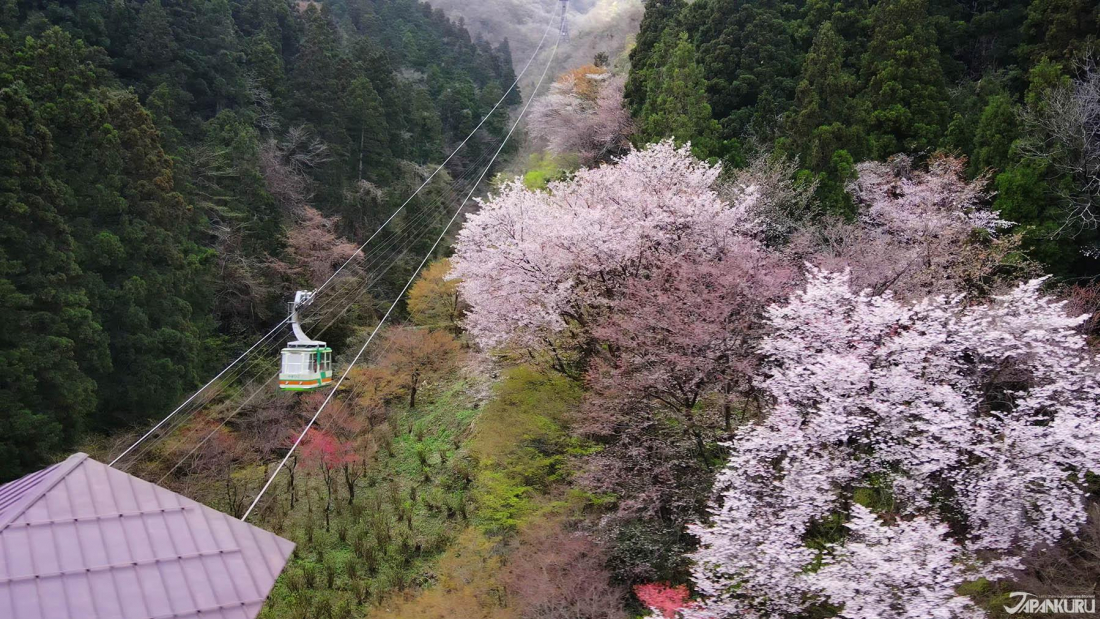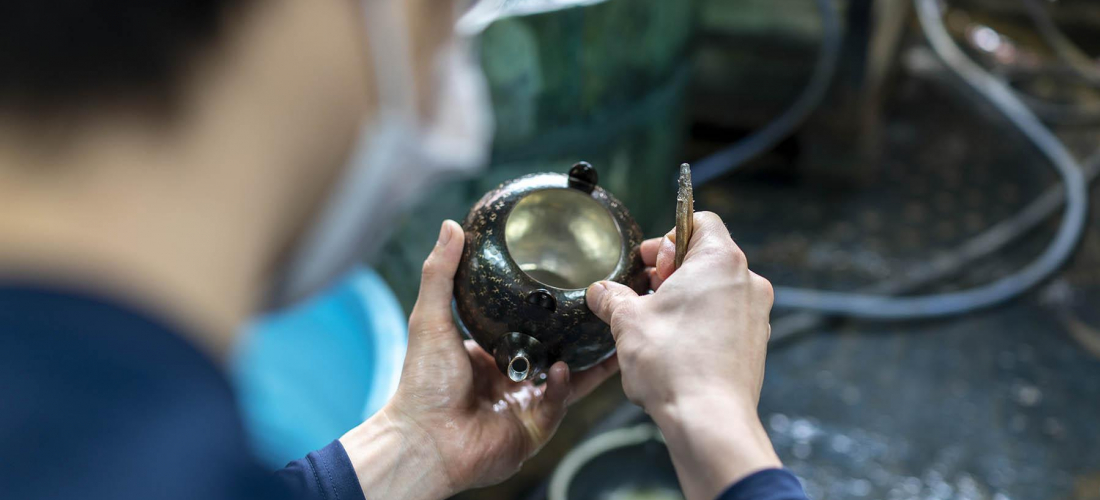
CONTENTS
Rejoignez Japankuru pour un voyage dans cette station de shinkansen JR EAST moins connue, à quelques pas des forêts anciennes du Japon, des montagnes majestueuses et des mers bleues étincelantes. Découvrez les meilleurs lieux à visiter recommandés directement par les membres de JR EAST!
Tsubame-Sanjo: Une nature magnifique qui inspire l’artisanat local
Prêt à réserver un billet shinkansen et à sortir de la grande ville? Niigata est un endroit idéal pour voir ce pour quoi la campagne japonaise est connue: des montagnes pittoresques, des champs de riz et de sarrasin, d'élégants sanctuaires à l'architecture traditionnelle, ainsi que des apparitions soudaines des eaux bleues de l'océan. De nos jours, les voyageurs descendent souvent à la gare Tsubamesanjō de Niigata pour voir les ateliers ouverts au public de la région et s'essayer à l'artisanat local, mais toute cette tradition culturelle a évolué grâce à l'abondance naturelle de la région. En effet, cette dernière est riche en ressources matérielles et en vues inspirantes! Venez avec nous contempler une montagne qui a stimulé des générations entières d'artisans.
Se rendre à la gare Tsubamesanjō
Etant un arrêt des trains à grande vitesse JR EAST, l'accès à la gare Tsubamesanjō est extrêmement pratique pour tous ceux qui partent de Tokyo ou des environs! La gare Tsubamesanjō est l'une des douzaines de la ligne Jōetsu Shinkansen, qui partent de la gare de Tokyo et s'arrêtent à la gare d'Ueno, avant de se diriger vers la préfecture de Niigata et d'arriver finalement dans la région de Tsubame-Sanjo!
Le trajet dure un peu moins de deux heures, ce qui en fait une destination idéale pour un week-end ou une petite excursion en utilisant l'un des pass ferroviaires de JR EAST. Ce JR EAST PASS (Nagano, région de Niigata) est particulièrement pratique pour se rendre à Tsubame-Sanjo: pour 18 000 yens, le pass vous permet de prendre n'importe quels trains de la JR EAST, y compris les shinkansen et les express, ainsi que certains bus. De Tokyo à la gare de Tsubamesanjō, un trajet coûte normalement 19 000 yen l'aller-retour, alors que le passe vous permet de vous promener librement dans tout Niigata et Nagano et ce pour moins cher. Vous n'avez d'ailleurs pas besoin d'être un simple touriste pour l'utiliser, même les étrangers résidant au Japon y ont droit!
JR EAST
"About JR EAST"
Site officiel (en)
"Seat Reservation Service Online for Shinkansen and Limited Express Train in East Japan Region"
JR EAST Train Reservations (en)
Mont Yahiko: Promenades appaisantes et paysages magnifiques
Le mont Yahiko a depuis longtemps des liens avec les croyances spirituelles locales, les dieux japonais et la mythologie. Elle est considérée comme une montagne sacrée (神 体 山), et les légendes racontent comment le dieu Ame no Kagoyama no Mikoto est arrivé au mont Yahiko et a appris aux habitants à prospérer. Des vestiges de cette connexion subsistent, comme on le voit dans l'imposant sanctuaire Yahiko établi au pied de la montagne, et même un petit sanctuaire au sommet, dédié à la montagne elle-même. De nombreux visiteurs ces jours-ci se dirigent également vers le mont Yahiko pour sa variété de sentiers de randonnée et ses superbes vues depuis le sommet, qui est de la même hauteur que la Tokyo Skytree!
Apprécier la nature: téléphérique du Mont Yahiko & son pont d’observation
Pour le touriste moyen (ou toute personne non équipée de matériel de randonnée et de bouteilles d'eau), le meilleur moyen d'atteindre le sommet du mont Yahiko est le téléphérique. Il part d'une petite gare au pied de la montagne, une courte randonnée (ou même une navette gratuite plus courte) depuis le sanctuaire Yahiko, et les voitures circulent jusqu'à la zone d'observation. Non seulement le téléphérique est pratique, mais c'est une expérience amusante qui offre une vue imprenable sur les paysages bucoliques entourant la montagne.
En glissant sur le flanc de la montagne en téléphérique, n'oubliez pas de regarder en bas! Au printemps, la saison des cerisiers en fleurs apporte une couleur supplémentaire à la vue ci-dessous, en commençant par "les sakura de montagne" (山 桜) en mars, suivi par les fleurs de cerisier "à plusieurs couches" (八 重 桜) et enfin le sakura local de Yahiko (弥 彦 桜), qui a six pétales au lieu de cinq! La saison se termine avec des érables qui virent à des nuances de rouge profond au milieu du printemps, ajoutant de nouvelles teintes roses.
Mount Yahiko Ropeway (弥彦山ロープウェイ)
Station au pied: 2898 Yahiko, Nishikambara District, Niigata
Tickets aller-retour: Adultes 1,500 yens / Enfants 750 yens
Official Website (jp)
Le téléphérique n'est cependant que le début! Lorsque vous atteignez le sommet, vous trouverez une zone d'observation où vous pourrez regarder de la même hauteur que la Tokyo Skytree, admirant la mer du Japon d'un côté du mont Yahiko, et le mosaïque de champs et de forêt de l'autre. Les hortensias égayent le bord de la montagne chaque été et les violettes à dents de chien fleurissent le long du chemin allant du téléphérique au petit sanctuaire situé au sommet de la montagne.
Si vous vous voulez faire une pause, la boutique de cadeaux vend à la fois des appéritifs et des plats chauds, comme par exemple d'énormes bols d'udon. Nous vous recommandons d'essayer le miso konyaku (味噌 こ ん に ゃ く), une spécialité locale à base d'un mélange spécial de pâtes de miso. Et lorsque vous êtes prêt à repartir, une "voiture d'escalade" vous emmènera faire un tour pour admirer le paysage de sa "tour panoramique" rotative! Cette dernière vous permettra de voir à 360 ° tout autour de la montagne, assis dans un siège confortable.
Panorama Tower
2898 Yahiko, Yahiko-mura, Nishikanbara-gun, Niigata
Tickets: Adultes 650 yens / Enfants 350 yens
Official Website (jp)
Sancturaire Yahiko: Saluer les dieux shinto
De retour au pied de la montagne, entrez par la porte rouge du sanctuaire et descendez le chemin pavé pour trouver le sanctuaire Yahiko, une belle structure entourée de grands arbres forestiers. Si vous vous rendez au mont Yahiko, vous remarquerez peut-être l'une des choses qui rend le sanctuaire célèbre pendant que vous êtes encore sur la route: une immense porte de sanctuaire dominant les voitures ci-dessous. À 30,16 mètres, la porte du sanctuaire Yahiko serait la plus grande du Japon. Bien sûr, les visiteurs qui viennent à pied peuvent toujours profiter des plus petites portes plus proches du sanctuaire lui-même.
Le sanctuaire Yahiko était cependant remarquable bien avant la construction de son énorme portail en 1982. Selon les légendes transmises au sanctuaire, Ame no Kagoyama no Mikoto (le dieu qui a apporté la prospérité à Yahiko) a été consacré au mont Yahiko la première année de l'ère de l'empereur Koan, le sixième empereur légendaire du Japon. Cela signifie que le sanctuaire Yahiko a été officiellement établi en 392 avant notre ère! Et tandis que la véritable histoire du sanctuaire est enterrée dans la légende, il y a des preuves plus vérifiables de sa longue histoire dans les pages du Man'yoshu, le plus ancien recueil de poésie du Japon, datant des années 600 à 759. Cela signifie que le sanctuaire a bien plus de mille ans.
Les bâtiments actuels du sanctuaire ont été reconstruits après un incendie au début du XXe siècle, et l'architecture traditionnelle centenaire est toujours en forme. En fait, les structures sont officiellement désignées comme biens culturels matériels importants. Ne manquez pas une chance de regarder autour de vous et de ressentir les millénaires de l'histoire japonaise imprégnés dans le sanctuaire la forêt environnante.
Yahiko Shrine (彌彦神社)
2887-2 Yahiko, Nishikambara District, Niigata
Official Website (jp)
Une région aux paysages magnifiques
Grâce à la mer du Japon, au sommet volcanique du mont Yahiko, aux champs verdoyants et aux forêts parsemées d'anciens sanctuaires, Tsubame-Sanjo est une région idéale pour profiter de la beauté de la campagne japonaise et voir pourquoi tant de voyageurs aiment se rendre un peu hors des sentiers battus au Japon. Si vous recherchez un endroit magnifique pour faire de la randonnée, une nouvelle façon amusante de voir la vue ou simplement une chance de visiter la préfecture de Niigata, il est temps de vous procurer un billet pour Tsubame-Sanjo.
▲ Les villes comme vous y êtiez dans notre vidéo de Tsubame-Sanjo!
Accès à Tsubamesanjō

・Moins de 2 heures depuis la gare de Tokyo jusqu'à Tsubamesanjō Station.

・5 jours d'accès aux trains JR EAST, tels que les shinkansen et "limited express" , ainsi que certains bus JR pour 18 000 yens.
・Disponible pour les voyageurs et residents étrangers.

Site officiel (en)

JR EAST Train Reservations (en)
Pour plus d'informations et de news sur le Japon, consultez Japankuru pour de noux articles, et n'oubliez pas de nous suivre sur twitter, instagram, et facebook!
Details
NAME:Tsubame-Sanjo Area
ACCESS:Tsubamesanjō Station (燕三条駅)
COMMENT
FEATURED MEDIA
VIEW MOREMAP OF JAPAN
SEARCH BY REGION

LATEST
VIEW MOREEVENT CALENDAR
VIEW MOREMOST POPULAR
 Tokyo Winter Recommendation: Don’t Miss Tokyo Mega Illumination, Japan’s #1 Light Show
Tokyo Winter Recommendation: Don’t Miss Tokyo Mega Illumination, Japan’s #1 Light Show ป้ายยาสินค้าน่าซื้อในร้านขายยาญี่ปุ่น | KOWA ผลิตภัณฑ์เพื่อสุขภาพสำหรับคนยุคใหม่
ป้ายยาสินค้าน่าซื้อในร้านขายยาญี่ปุ่น | KOWA ผลิตภัณฑ์เพื่อสุขภาพสำหรับคนยุคใหม่ Okinawa Family Road Trip: Japanese Glasses Shopping at San-A Urasoe West Coast PARCO CITY, Discount Coupons, & Okinawa Sightseeing with JINS
Okinawa Family Road Trip: Japanese Glasses Shopping at San-A Urasoe West Coast PARCO CITY, Discount Coupons, & Okinawa Sightseeing with JINS













 >> Find out more at Japankuru.com! (link in bio)
#
>> Find out more at Japankuru.com! (link in bio)
#





 The Robot Restaurant is gone, but the Samurai Restaurant is here to take its place. Check it out, and don't forget your coupon!
The Robot Restaurant is gone, but the Samurai Restaurant is here to take its place. Check it out, and don't forget your coupon!
 신주쿠의 명소 로봇 레스토랑이 사무라이 레스토랑으로 부활! 절찬 쿠폰 발급중
신주쿠의 명소 로봇 레스토랑이 사무라이 레스토랑으로 부활! 절찬 쿠폰 발급중
 18歲以上才能入場的歌舞秀,和你想的不一樣!拿好優惠券去看看~
#tokyo #shinjuku #samurairestaurant #robotrestaurant #tokyotrip #도쿄여행 #신주쿠 #사무라이레스토랑 #이색체험 #할인이벤트 #歌舞伎町 #東京景點 #武士餐廳 #日本表演 #日本文化體驗 #japankuru #japantrip #japantravel #japanlovers #japan_of_insta
18歲以上才能入場的歌舞秀,和你想的不一樣!拿好優惠券去看看~
#tokyo #shinjuku #samurairestaurant #robotrestaurant #tokyotrip #도쿄여행 #신주쿠 #사무라이레스토랑 #이색체험 #할인이벤트 #歌舞伎町 #東京景點 #武士餐廳 #日本表演 #日本文化體驗 #japankuru #japantrip #japantravel #japanlovers #japan_of_insta
 코지마 x 빅 카메라 쿠폰으로 일본 가전 제품 쇼핑하기
#pr #japankuru #japanshopping #kojima #biccamera #japaneseskincare #yaman #dji #osmopocket3 #skincaredevice #日本購物 #美容儀 #相機 #雅萌 #日本家電 #일본여행 #면세 #여행꿀팁 #일본쇼핑리스트 #쿠폰 #일본쇼핑 #일본브랜드 #할인 #코지마 #빅카메라 #japankurucoupon
코지마 x 빅 카메라 쿠폰으로 일본 가전 제품 쇼핑하기
#pr #japankuru #japanshopping #kojima #biccamera #japaneseskincare #yaman #dji #osmopocket3 #skincaredevice #日本購物 #美容儀 #相機 #雅萌 #日本家電 #일본여행 #면세 #여행꿀팁 #일본쇼핑리스트 #쿠폰 #일본쇼핑 #일본브랜드 #할인 #코지마 #빅카메라 #japankurucoupon








































